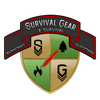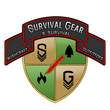Guide To The Best Buschraft Knives

Choosing the most important bushcraft knife is always a personal and important decision for any bushranger. Of course you want a knife that looks cool. But even more importantly, when venturing out into the wild, you need to be sure that you have chosen a tool that you can confidently rely on. Unfortunately, the market is saturated with expensive “survival knives” that simply do not make the cut (pun intended). There are a number of factors to consider when purchasing an authentic survival knife. Luckily for you, we’ve broken down everything you need to know about purchasing a bushcraft knife to help protect you, and your pocketbook, from suffering.
So on that note, here is Survival Gear’s short guide to selecting your ideal bushcraft knife:
1. Function
Bushcraft knives are designed to carry out specific functions. These knives are crafted to saw through rope, carve wood, cut tree limbs, skin animals, clean wild game, and even dig. Because bushrangers need a tool that is durable, reliable, and flexible, these knives are ideal for activities carried out in the wilderness.
What functions do you expect your knife to serve? If you’re looking for something more tame than the activities listed above, like peeling apples, then you may want to consider purchasing a standard pocket knife. If you are planning on surviving in the wild for any period of time, then you need a bushcraft knife.
2. Price
As a general rule: you get what you pay for.
However, there are always exceptions to this rule. The MORA companion knife is one such exception. Priced at only $24.95, this tough knife easily cuts through any task laid before it. The MORA brand offers an array of quality bushcraft knives at relatively cheap prices. High quality and low price does not mean that you have to compromise on aesthetics either. For example, the brand has manufactured the MORA companion knife in pink and orange for bushrangers that appreciate bright colors. While these particular MORA knives are great tools and offer decent quality, there are better (although more expensive) options available. This is where that general rule comes back into play...
Being one of the most ergonomic bushcraft knife options on the market, the TOPS BOB Field Hunter survival knife is worth dropping a pretty penny on. The cutting power and ergonomic design of the ESEE-6 Tactical Dark Earth knife makes it worth its price tag as well. These are only a few examples of items provided by reputable brands, but the best knives are going to cost you. Be prepared to invest around $100 or more on a high quality bushcraft knife.
3. Type of Metal
Our ancestors constructed blades out of shards of rock. Thankfully though, as we have evolved, so have our blade material options.
As a general rule, the best bushcraft knives wield blades made from steel. As an alloy of iron, additional elements are added to increase the strength of steel. Additionally, these additives affect the type of steel that is formed. Most steels that are used in creating bushcraft blades can be classified as either Stainless or Carbon.
Due to a relatively high percentage of chromium in the blade that forms a protective oxide coating, the oxidation process and corrosion are greatly reduced in stainless steel blades.
Stainless steel blades are typically low maintenance. They are ideal for when you find yourself in environments that don’t allow for much time to invest in caring for your knife, like on a kayaking trip or fishing trip.
If you plan on using your knife primarily for game preparation, you may want to consider a stainless steel knife. Thanks to its resistance to corrosion and oxidation, a stainless steel knife will not form a patina. (A patina, a green or brown film caused by oxidation, can cover the blade in bacteria-- making it unsanitary and potentially unsafe for the blade to come in contact with food).
The increased percentage of carbon in this type of blade makes it incredibly durable. They are often much stronger and sharper than stainless steel knives. For this reason, carbon steel blades are a favorite of expert bushrangers.
Carbon steel blades, however, require conscientious maintenance with regular sharpening, honing, and oiling. Additionally, they must be stored properly. If damp when stored, the blade will certainly rust at an alarming rate.
Despite being a more high maintenance blade, carbon steel is easier to sharpen than stainless steel and is a better tool to opt for when taking on carving projects.
4. Handle Design
Picking a knife based on looks alone is tempting, but foolish. You need to pick a knife that feels comfortable in your hand. Remember: you are investing in a tool, not an accessory. If the grip on the knife is uncomfortable, then it will not be able to serve the purpose for which you have purchased it. Cutting, sawing, carving, cleaning game, etcetera is virtually impossible with the wrong tool.
Oval shaped handles tend to be the most comfortable option for the majority of people. Squared edges and engraved handles designs should be avoided. You will likely be using this knife for an extended period of time, often exerting considerable force in your grip on the handle. Make sure you pick a design that allows you to carry out the knife’s intended function effectively.
As a general guide for handle material:
- Stainless steel - heavy, but provides a decent grip
- Aluminum - lightweight, decent grip, and is aesthetically pleasing
- Titanium - lightweight and provides a nice grip
- G-10 - provides a nice grip, but does not make for a good looking handle
- Carbon fiber - provides a nice grip and is very eye-catching
- Paracord - does not have a nice grip and is not pleasing to the eye
- Bone - very beautiful material, but does not provide an ideal grip
- Wood - decent grip and looks great
- Leather - good grip and aesthetically pleasing
Final Thoughts
To summarize, pick a knife that:
- Has the capability of carrying out the tasks you intend to use it for
- Can grip comfortably
- Is made of material that you know how to properly care for
Additionally, it’s vital to stay up to date with the latest legislation regarding the use of knives. Your bushcraft knife may be your most treasured asset in your eyes, but there are others who will simply see it as a weapon. As such, be sure to respect the law.
A bushcraft knife is a great survival tool and should be respected as such. Proper care and use is necessary to ensure the longevity of your new asset.
Best of luck in choosing your new bushcraft knife!







Leave a comment